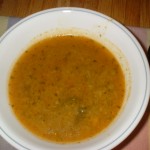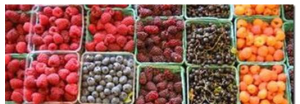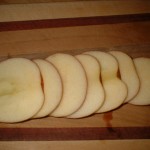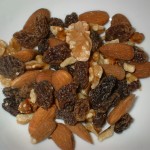By Catharine L. Kaufman—a.k.a. The Kitchen Shrink
Hello again, fellow foodies!
Here is the second batch of 10 tried and true food handling, storing and cooking tips for your collection. Some of these I stumbled upon by accident or trial and error while searching for help to prevent or repair culinary glitches. The rest were gathered from other food-impassioned solution seekers and, of course, thoroughly tested in my kitchen before being added to this list. .
1) Soup Rescues:
 (a) Remove Excess Fat by floating a crisp lettuce leaf on top of your cooling soup for a few seconds and scooping it out carefully. The lettuce acts like a fat-magnet. Use more than one leaf if necessary.
(a) Remove Excess Fat by floating a crisp lettuce leaf on top of your cooling soup for a few seconds and scooping it out carefully. The lettuce acts like a fat-magnet. Use more than one leaf if necessary.
(b) Thicken Soup by boiling it up for a minute with a handful of fast-cooking pasta (small alphabet or skinny angel hair noodles), or sprinkle some potato flakes on it and simmer for a few seconds. Adding cooked rice or croutons to the bowl when serving, also gives body to the soup.
(c) Enrich the Flavor by adding the herbs and spices to your soup during the last five minutes of the cooking process.
2) Lemon Squeeze: To get the most juice out of a lemon, keep it at room temperature for a day (or immerse it into a bowl of hot water for a few minutes), then, with your palm, roll it on a hard surface back and forth until the rind feels supple and the lemon softer. Important Tip: After you have squeezed the last drop, plastic-wrap tightly the remaining pulp and rind and store it in your freezer to use later for cake batters,  risottos, stews or other dishes.
risottos, stews or other dishes.
3) Flour Protection: To prevent bugs from taking up residence in your flour, store it in a wide-mouth glass jar and add a bay leaf to keep pests away. Or store it in a freezer-safe Pyrex container in your freezer to make sure that if any stray (pinhead-size) moth eggs managed to sneak through the grain milling process, they can never hatch.
4) Slick Your Noodles: To keep pasta from sticking together, add a couple of tablespoons of olive oil to the boiling water before immersing the noodles. Strain when done and gently fold another tablespoon or two of olive oil (per package) into the finished pasta. Useful Tip: Undercook by a few minutes (based on package directions) any pasta you intend to bake or cook further—such as lasagna, ziti prepared as a casserole, stuffed shells, etc.
5) Keep Berries Free Of Mold: Rinse only the amount you plan to eat or serve right away. If, however, you intend to keep berries in the refrigerator for  a few days, give them a quick rinse first in a weak dilution of water and apple-cider vinegar, drain in a sieve and air-dry in a cool place for an hour or so, then refrigerate in an open bowl.
a few days, give them a quick rinse first in a weak dilution of water and apple-cider vinegar, drain in a sieve and air-dry in a cool place for an hour or so, then refrigerate in an open bowl.
6) Apples Won’t Turn Brown when squirted with lemon juice before storing.
7) Mushrooms Are Best Stored in a paper (not plastic) bag—but should be cooked (or eaten raw) within a day, since they go bad very quickly. Useful Tip: Brush off dirt with a soft brush, cut off stem bottoms, give mushrooms a quick cold water rinse in a colander and drain well before either cooking the fungi or serving raw edibles in salads.
since they go bad very quickly. Useful Tip: Brush off dirt with a soft brush, cut off stem bottoms, give mushrooms a quick cold water rinse in a colander and drain well before either cooking the fungi or serving raw edibles in salads.
8) Potato-Wise: Keep potatoes in a cool, dark place until ready to be cooked. Potatoes tend to rot faster when onions are stored nearby. Use potatoes before they get a chance to germinate. Scrub them with a brush and rinse with cold water. Examine the spuds carefully and gouge and discard each sprouted ‘eye’ before cooking. (Sprouting tendrils contain a mild toxin the plant creates to protect its offspring.) Cook potatoes with their nutritious and edible skin. This versatile root can be prepared in many ways—from mashed with yogurt, cooked spinach or broccoli; to baked or roasted after being sliced in the shape of coins or French fries and tossed to be well-coated in a mixture of olive oil, balsamic vinegar, herbs and spices.
9) Yummy Ruby Yams: As with potatoes, store yams in cool, dark place, scrub and rinse, discard sprouting ‘eyes,’ slice, coat with olive oil mixture as above and bake or roast for a savory side dish. Surprise Tip: Yams also make glorious desserts. A quick and easy one includes cutting the tuber into big chunks; boiling in water until soft; peeling and mashing; adding vanilla and cinnamon to taste (and proportional to quantity); sprinkling a handful of plumped up raisins or dried cranberries; and carefully folding in whipped cream (optional). For a grownup party version, add a dash of dark rum, Grand Marnier or other liqueur.
 10) In A Nutshell: Since nuts and seeds have a high fat content and tend to go rancid rather quickly, store them in tightly closed glass containers in the fridge or freezer to keep light and moisture out. They generally last four months in the refrigerator and eight months in the freezer with their texture intact. Nuts and seeds tend to pick up the taste and odor of nearby foods, so it’s best to keep them in solitary confinement. Taste before use because a few rancid pieces can ruin a whole dish. Delicious Tips: Toss and bag nuts, seeds and dried fruit into a healthy, energy-boosting Trail Mix and add to kids’ lunch boxes or a picnic basket. Also, various combinations of the Mix make great additions to stir-fries, ice cream toppings, cereals and more. Here is my favorite recipe for a Sweet and Savory Toasted Nuts combo:
10) In A Nutshell: Since nuts and seeds have a high fat content and tend to go rancid rather quickly, store them in tightly closed glass containers in the fridge or freezer to keep light and moisture out. They generally last four months in the refrigerator and eight months in the freezer with their texture intact. Nuts and seeds tend to pick up the taste and odor of nearby foods, so it’s best to keep them in solitary confinement. Taste before use because a few rancid pieces can ruin a whole dish. Delicious Tips: Toss and bag nuts, seeds and dried fruit into a healthy, energy-boosting Trail Mix and add to kids’ lunch boxes or a picnic basket. Also, various combinations of the Mix make great additions to stir-fries, ice cream toppings, cereals and more. Here is my favorite recipe for a Sweet and Savory Toasted Nuts combo:
1 cup assorted shelled nuts (walnuts, almonds, cashews, etc.)
¼ teaspoon sea salt
¼ teaspoon cinnamon
a shake or two cayenne pepper (to taste)
¼ teaspoon powdered cumin
a dash nutmeg
¼ cup brown sugar
2 tablespoons butter (for low-cholesterol version use walnut, almond, sesame or sunflower oil)
1 teaspoon Worcestershire sauce
In a mixing bowl, combine salt and spices and set aside. In a skillet melt butter or heat oil on medium, add nuts and toast. Add remaining ingredients and a teaspoon of water. Cook on low heat until sugar is melted. Spread the combination on parchment-lined cookie sheet and cool. Store in airtight containers.


2 Comments on “More Food Tips (Part II)”
From: fred zeller
Date: October 8, 2012 12:05:57 PM PDT
To:
Subject: Meyer Lemon Cookie recipe
Hi Catharine,
I enjoyed seeing your posting online (http://www.delmartimes.net/2012/10/04/kitchen-shrink-tips-and-tricks-of-the-culinary-trade/) as well as your article in the North Coast newspaper for “Pucker Up Meyer Lemon Cookies”.
With all of the ingredients on hand in my kitchen, I made two batches this past weekend. Simple recipes like this are great, and so easy to prepare. What caught my attention was the special ingredients of Meyer Lemon juice, and zest, which made for a very unique and flavorful cookie. The cookies were a big hit at my house, with nearly both batches almost gone in fact.
I am enclosing two photos, one on a cookie sheet and another in a keep fresh container. While I baked them at 350 degrees for 14 minutes, they came out amazingly soft and bursting with flavor. I thought you may like these alternative photos, as the photo in your posting is not very flattering compared to how my batches came out.
Thanks again for your posting. This recipe is a keeper.
Regards, Fred
P.S. Thanks for posting your website @ http://freerangeclub.com/
i always put herbs and spices on every meal that i cook.*
My current blog site
http://www.homeimprovementstuffs.com/best-types-of-water-container/